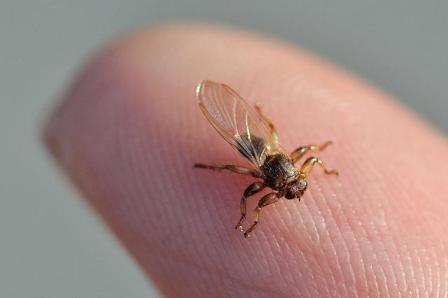Tsetse fly
The tsetse fly has the glory of an extremely dangerousof an insect. It is able to cause in humans and animals an illness called trypanosomiasis. There are two forms of this infection: Rhodesian trypanosomiasis, sometimes called East African, and Gambian, or West African. Rhodesian is transmitted from animal to animal and mainly affects cattle, horses, wild ungulates. The Gambian form is common among people, it is usually called a sleeping sickness. The tsetse fly lives only in Africa. There are 22 species of this insect. It is active throughout the day and feeds exclusively on blood.
Most insects, as a rule, negligentparents. The female lays eggs and flies away, leaving the young to survive on their own. The tsetse fly differs from other insects in that it is very careful about its offspring. The female lays one egg, but it contains it in the safest place - in its uterus. The egg turns into a larva that grows by eating a liquid rich in fats, called by scientists "intrauterine milk." When the larva completely fills the mother's uterus, it releases it into the moist soil. The larva hides and immediately pupates.
As research has shown, "milk" containsenzyme sphingomyelinase, which is activated in an acidic environment in the digestive tract of the larva. Sphingomyelinase is involved in the metabolism of fats and the formation of cell membranes. This enzyme has similar functions in mammals and tsetse flies during lactation, despite the enormous evolutionary distance between these classes. In addition to the parasitizing organism - trypanosome, there is another bacterium living in its digestive tract, simultaneously evolving with its host for millions of years - the endosymbiotic bacterium Wigglesworthia glossinidia. It provides the insect with nutrients, the fly's ability to reproduce depends on it. Perhaps this knowledge will someday be used by scientists to prevent the spread of the disease. When removing bacteria from an insect, scientists can reduce its fertility and, accordingly, the transmission of the disease.
The bite of a tsetse fly is very dangerous. It is the carrier of tiny unicellular organisms of trypanosomes, having dimensions equal to the size of red blood cells. There are several types of parasites divided into categories according to their influence on vertebrates. Some species do not cause any health problems, while other strains are extremely dangerous. The insect, in the process of feeding, acquires them from infected vertebrates and then transmits it to an uninfected animal through saliva.
Trypanosome lives in the digestive tractan insect for several days, after which it moves to the salivary glands. The tsetse fly, most likely, does not react to these parasites, but it is possible that they increase the chance for the insect to survive. The fact is that trypanosomes have evolved significantly and formed their own life cycle, which requires a certain time, depending on the hosts.
Morphologically, the insect exists in two forms: a larva of the third age stage (when it is separated from the mother) and an adult.
The adult fly is a relatively largean insect, a length of 0.5 to 1.5 centimeters, with clearly defined characteristics. She has a large head with a characteristic proboscis, large eyes and unusual antennas, with awns with branched hairs at the ends. The thorax is quite large, the abdomen is wide, but not elongated, it is shorter than the wings, which have a specific feature in front of them: a segment resembling an ax.








